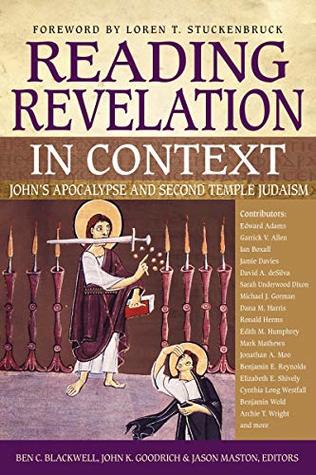More on this book
Kindle Notes & Highlights
by
Zondervan,
Read between
May 31 - July 6, 2025
Comparison with other apocalypses, such as 4 Ezra, helps us to see that the primary reference for this imagery is found in the first century, not the twenty-first.
Revelation presents a much more dualistic perspective, envisioning either a full commitment to Christ or an opposition to his kingdom.
Though the apocalyptic fervor of Revelation seems focused on generating fear, it has two purposes—giving hope for the righteous and warnings for the rebellious.
In the Old Testament and in early Jewish literature, there are several instances when the recounting of exodus plagues is shortened from ten to seven (Ps 78:44–51; 105:28–36; 3 Bar. 16:3; Wis 11–19). By referring to only seven plagues, John’s Apocalypse clearly falls within this tradition.
Words of the Luminaries (4Q504 frags. 1–2 col. V) is concerned with interpreting and retelling the exodus, from captivity to wandering in the wilderness. This retelling is for the benefit of the author’s community (which he perceives to be in a state of theological exile) and is accomplished in part by echoing Leviticus 26 throughout the passage.
Words of the Luminaries envisages that everything Leviticus 26 forewarns regarding exile has come
to pass (including the Egyptian “plagues” revisited upon Israel; cf. l. 18), but that God will redeem an elect group just as he redeemed Israel from Egypt.
Richard Bauckham offers an especially intriguing study on the relationship of John’s septets to Leviticus 26.
four septets of plagues in Revelation, not just three.
Bauckham convincingly argues that the significance of the plagues’ pattern is that it depicts a perfect judgment enumerated as four sets of seven—as in Leviticus 26 where God four times promises to punish Israel “seven times over” (26:18, 21, 24, 28).
In Revelation 7:5–8, the twelve tribes of Israel are idealized (12 x 12,000) and depict the “true Israel” (= the Christian church) and this, in turn, evokes remnant imagery (cf. Rom 9:27–29; 11:4–6).
The twelve tribes of Revelation 7, in light of Ezekiel 48:1–29, suggest that a characteristic of remnant ideology is the reunification of Israel at the time of the eschaton.
In Revelation 5, the lamb that has been slain is not only the paschal lamb but also a way of recalling Israel’s exodus from Egypt.
Words of the Luminaries suggests that John drew upon a wider pastiche of scriptural traditions that includes Leviticus 26 with Exodus, which are used together to reflect on exile.
the novel Aseneth probably was known when John wrote Revelation. We cannot claim that John intended a contrast between his villainous woman and Aseneth, but the use of symbolic women in ancient writings emboldens us to find helpful connections
Its main question is the one begged in Genesis—what is a good Jewish boy like Joseph doing marrying the daughter of a pagan priest? The answer is that the marriage is God’s will, because gentiles can be incorporated into Israel.
Feminine figures, then, can be used both in a novel that urges wisdom, and in a revelatory piece about the new heaven and new earth. In Aseneth, we can see a figure to emulate. By Babylon, we are driven to the One who is the Light.
Similar links between wealth and oppression, violence and idolatry are found in 1 Enoch 94:6–100:6, which form part of a major section of an apocalyptic text that was very popular in Second Temple Judaism.
The text also confronts how money is linked to hypocrisy: it can deceptively be used to make one appear to be righteous (96:4), which is another form of social power. Prosperity can be falsely linked to righteousness as a sign of God’s blessing.
The rich are indicted for having many “laborers” in their house (97:9b), which would certainly include slaves (slavery is specifically denounced in 98:4).
Psalms of Solomon, which contains what is arguably the most important messianic text in Second Temple literature.
Psalms of Solomon is a collection of eighteen hymns to God, compiled in the first century BC, that became part of the Greek Bible, or Septuagint.
The messianic Psalm 17, at forty-six verses in modern versions, is the longest.
This means that John reads Scripture christologically—in light of Jesus. Because Jesus established his messianic kingdom by dying rather than killing, John interprets scriptural images of divine and messianic violence, including Isaiah 63, nonviolently.
Below, I show how the story line of Revelation 20:1–15 maps onto that in 1 Enoch 10:4–8, 11–15, thus reflecting a common stream of tradition:
John further adapts the stream of exegetical tradition by fusing it with Ezekiel 38–39—the account in which Gog and Magog attack God’s people—to describe Satan’s final assault.
Fourth Ezra rejects political revolt and violence. God alone will bring in the age to come.
Bauckham, Richard. The Climax of Prophecy: Studies on the Book of Revelation. Edinburgh: T&T Clark, 1993.
So when John uses the angelic refusal scene to elevate the status of his message, he is not elevating his own status as the author, but elevating Christ himself. This is one of the many ways John puts Christ on par with God.


